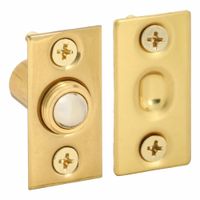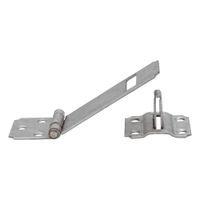Call +(254) 703 030 000 / 751 483 999 / 721 704 777
.....Read More
Frequently Asked Questions
What is the difference between a hasp and a latch?
A hasp and a latch are both types of fasteners used to secure doors, gates, or containers, but they function differently.
A latch is a mechanism that holds a door or gate closed but does not necessarily lock it. It typically consists of a movable part that engages with a strike plate or a similar component on the door frame. Latches are often operated by a handle or a knob, allowing for quick and easy opening and closing. They provide a basic level of security, preventing the door from swinging open freely, but can usually be opened without a key.
A hasp, on the other hand, is a hinged metal plate with a slot or opening that fits over a staple or a loop. To secure something with a hasp, a padlock or some other locking device is then passed through the staple, holding the hasp in place and preventing it from being opened. Hasps are designed to provide a more robust and secure fastening solution than a simple latch, as their security depends on the strength of the padlock used with them. They are commonly found on sheds, chests, and gates where a higher level of security is desired.
In summary, a latch offers convenient closure and basic security, while a hasp, when combined with a padlock, provides a more substantial and secure method of fastening.
How do you install a hasp on a door?
To install a hasp on a door, you'll need a few tools: a drill, a screwdriver, a pencil, and the hasp itself (which typically includes the hasp, staple, and screws).
First, determine the best placement for the hasp on the door and frame. It should be positioned so that when the door is closed, the hasp arm can easily swing over the staple. Use a pencil to mark the screw holes for the hasp on the door.
Next, pre-drill pilot holes at your marked spots. This helps prevent the wood from splitting and makes it easier to drive in the screws. Attach the hasp to the door using the provided screws and a screwdriver.
Now, close the door and align the staple with the hasp arm. Mark the screw holes for the staple on the door frame. Again, pre-drill pilot holes for the staple. Finally, secure the staple to the door frame with the remaining screws. Test the hasp to ensure it latches securely.
What are the best types of latches for cabinets?
For cabinets, various latch types offer different benefits depending on your needs for security, aesthetics, and functionality. Magnetic latches use magnets to hold cabinet doors shut, offering a clean look and easy opening, ideal for frequently accessed cabinets. Roller catches provide a simple mechanical solution, using a spring-loaded roller to hold the door, which is durable and effective for standard use. Ball catches, similar to roller catches, use a spring-loaded ball and are often found on bifold doors or where a minimal profile is desired. Touch latches, or push-to-open latches, allow cabinets to be opened by simply pressing the door, eliminating the need for handles and creating a sleek, modern aesthetic. Child-proof latches, such as strap locks or magnetic key locks, are essential for safety in homes with young children, providing robust security. For a more traditional or decorative look, turn latches or barrel bolts can be used, offering a visible securing mechanism. Each type has its advantages, so the "best" choice depends on the specific cabinet, its location, and the desired user experience.
How does a cam latch work?
A cam latch operates on a simple yet effective principle of rotation and engagement. It consists of a cam, which is typically an irregularly shaped disc or lever, and a strike plate or frame. When the cam is rotated, usually by turning a handle or a knob, its eccentric shape interacts with the strike plate. As the cam turns, it pushes against the strike plate, either pulling a door or panel tightly shut or releasing it. The cam's design dictates the latch's action; some cams provide a tight compression, while others offer a simple pivot. The mechanism is often used in situations where a secure, quick-release closure is needed, such as cabinets, enclosures, or industrial machinery. The rotation of the cam directly translates into a linear or rotational force that engages or disengages the latch, providing a secure and reliable closing mechanism.
What is a compression latch used for?
A compression latch is a type of mechanical fastener used to secure two or more surfaces together while applying a compressive force. This force pulls the mating surfaces tightly together, creating a secure and often vibration-resistant seal. They are commonly used in applications where a tight seal is crucial, such as to prevent dust, moisture, or noise ingress, or to reduce rattling in moving parts.
Key uses include: * **Enclosures and Cabinets:** Securing doors and panels on electrical enclosures, industrial machinery, and outdoor cabinets to protect contents from environmental factors and tampering.
* **Vehicles:** Used in automotive, marine, and aerospace applications for securing access panels, compartments, and doors, where vibration resistance and a tight seal are important for safety and performance.
* **HVAC Systems:** Sealing access panels on air ducts and HVAC units to prevent air leakage and maintain system efficiency.
* **Railway and Mass Transit:** Used on train doors and access panels for both security and to reduce noise and vibration.
* **Medical Equipment:** On specialized medical devices where a clean, sealed environment is necessary.The "compression" aspect refers to the action of the latch drawing the door or panel tightly into the frame, effectively compressing any gasketing material and ensuring a secure closure that is resistant to loosening from vibrations or minor impacts.
How do you choose the right latch for a toolbox?
Choosing the right latch for a toolbox depends on several factors, including the type of toolbox, the level of security needed, and the environment in which it will be used. For basic security and ease of access, a simple toggle latch or a draw latch might suffice. These are common for general-purpose toolboxes. If you need a higher level of security to protect valuable tools, a padlockable latch or a keyed cam lock would be more appropriate. These options allow for external locking mechanisms, deterring theft.
The material of the latch is also important. For outdoor use or in humid environments, corrosion-resistant materials like stainless steel or zinc-plated steel are recommended. For heavy-duty toolboxes or those that will be subjected to significant vibration, a robust, heavy-duty latch made from thick gauge steel or cast iron would be more durable. Consider the mounting style as well; some latches are surface-mounted, while others are recessed. The size and strength of the latch should be proportionate to the size and weight of the toolbox and its contents to ensure a secure closure. Finally, think about the ergonomics – how easy is the latch to open and close, especially if you're frequently accessing your tools?
What are the security benefits of using door bolts and chain guards?
Door bolts and chain guards significantly enhance home security by providing additional layers of protection against forced entry. Door bolts, such as deadbolts, operate independently of the doorknob lock and extend a solid metal bolt into the door frame, making it much harder to kick in or pry open the door. They offer superior resistance to brute force attacks compared to standard spring-latch locks.
Chain guards, while not as robust as deadbolts, serve a crucial purpose by allowing occupants to partially open the door to communicate with visitors without fully exposing themselves. This provides a safe way to screen callers and prevents uninvited individuals from pushing their way inside. They act as a deterrent and give residents control over who enters their home.
Together, these devices create a formidable barrier. The deadbolt deters direct forceful entry, while the chain guard adds an extra layer of caution for interactions at the doorstep. This combination improves peace of mind by making a home less vulnerable to burglaries and enhancing personal safety.
How do you maintain and lubricate latches and catches?
To maintain and lubricate latches and catches effectively, start by regularly cleaning them to remove dirt, dust, and grime that can impede their function. Use a soft cloth and a mild cleaner, ensuring the area is completely dry afterward.
For lubrication, choose a suitable lubricant such as silicone spray, graphite powder, or a light oil like WD-40, depending on the material and exposure of the latch or catch. Apply the lubricant sparingly to all moving parts, including hinges, springs, and sliding mechanisms. Work the latch or catch several times to distribute the lubricant evenly. This not only ensures smooth operation but also helps prevent rust and corrosion, extending the lifespan of the hardware. For outdoor applications or areas exposed to moisture, consider a water-resistant lubricant. Avoid over-lubricating, as this can attract more dirt and lead to buildup.
What materials are hasps and latches typically made from?
Hasps and latches are commonly made from durable materials to ensure security and longevity. Steel, particularly carbon steel and stainless steel, is a popular choice due to its strength, resistance to impact, and ability to withstand harsh environments. Stainless steel offers superior corrosion resistance, making it suitable for outdoor or marine applications.
Brass and bronze are also used, especially for decorative or architectural purposes, as they offer good corrosion resistance and an attractive finish. These materials are often found in historical or traditional designs. For lighter duty applications or specific environments, materials like aluminum, zinc alloys, or even certain plastics may be used. Aluminum is valued for its lightweight yet strong properties, while zinc alloys provide good castability and are often used for more intricate designs. The choice of material ultimately depends on the intended use, desired security level, and environmental conditions.
How do you replace a broken latch on a cabinet or door?
Replacing a broken latch on a cabinet or door typically involves a few straightforward steps. First, you'll need to assess the type of latch that's broken. Common types include spring-loaded roller catches, magnetic catches, and various styles of bolt or lever latches. Once you've identified the type, you can purchase a suitable replacement at a hardware store.
Next, carefully remove the old latch. This usually involves unscrewing it from the cabinet or door frame using a screwdriver. For door latches, you might also need to remove the handle or knob to access the internal mechanism. Take note of how the old latch was installed, as this will help with the reinstallation of the new one.
Before installing the new latch, clean the area where the old latch was mounted to ensure a smooth surface for the new one. Then, align the new latch with the pre-drilled holes or marking new pilot holes if necessary. Secure the new latch in place with screws, making sure it's firmly attached and aligned correctly. If it's a door latch, reattach the handle or knob.
Finally, test the new latch to ensure it functions properly. Open and close the cabinet door or regular door a few times to confirm that the latch engages securely and releases smoothly. Adjust the position slightly if needed to achieve optimal performance. With these steps, you can effectively replace a broken latch and restore the functionality of your cabinet or door.






